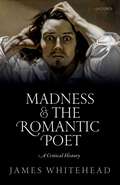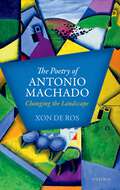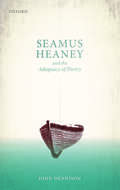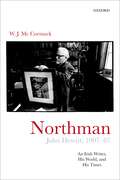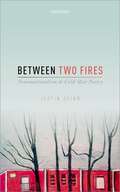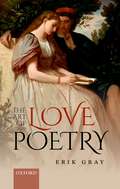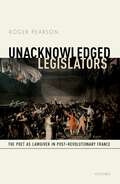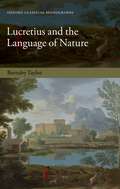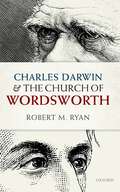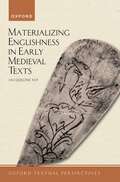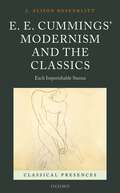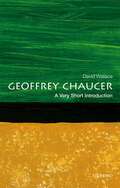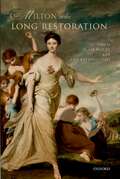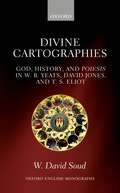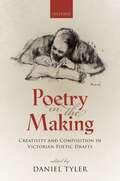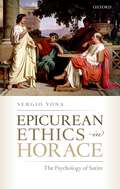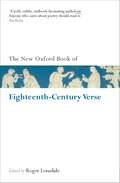- Table View
- List View
Madness and the Romantic Poet: A Critical History
by James WhiteheadMadness and the Romantic Poet examines the longstanding and enduringly popular idea that poetry is connected to madness and mental illness. The idea goes back to classical antiquity, but it was given new life at the turn of the nineteenth century. The book offers a new and much more complete history of its development than has previously been attempted, alongside important associated ideas about individual genius, creativity, the emotions, rationality, and the mind in extreme states or disorder - ideas that have been pervasive in modern popular culture. More specifically, the book tells the story of the initial growth and wider dissemination of the idea of the 'Romantic mad poet' in the nineteenth century, how (and why) this idea became so popular, and how it interacted with the very different fortunes in reception and reputation of Romantic poets, their poetry, and attacks on or defences of Romanticism as a cultural trend generally - again leaving a popular legacy that endured into the twentieth century. Material covered includes nineteenth-century journalism, early literary criticism, biography, medical and psychiatric literature, and poetry. A wide range of scientific (and pseudoscientific) thinkers are discussed alongside major Romantic authors, including Wordsworth, Coleridge, Blake, Hazlitt, Lamb, Percy Bysshe Shelley, Keats, Byron, and John Clare. Using this array of sources and figures, the book asks: was the Romantic mad genius just a sentimental stereotype or a romantic myth? Or does its long popularity tell us something serious about Romanticism and the role it has played, or has been given, in modern culture?
The Poetry of Antonio Machado: Changing the Landscape
by Xon De RosThis study offers a reappraisal of the contribution of the poet Antonio Machado to Modernism, seeking to open up new perspectives for the interpretation of his poetry, and includes for the first time a comparative analysis of Machado's translators into English. While the book is attentive to areas of recent critical debate, the argument keeps Machado's poems to the fore, with new detailed readings of many of his most significant poems. The reader will find that the structure of this book also allows for a separate exploration of each of Machado's main poetic tendencies. One associated with the Symbolist poetics is considered in Chapter I dealing with those early poems where the sound of water acquires a rich symbolic meaning. An emphasis on the visual imagination is more prevalent in the material studied in chapters II and III with a focus on the natural landscape, while the more conceptual and intellectual strand occupies Chapter IV. Every individual chapter begins with a brief introduction to the theoretical ground related to the specific discussion (on gender, space-place, the sublime, and translation, respectively), and a survey of the cultural discourses which situate the material under analysis in the original historical contexts.
Seamus Heaney and the Adequacy of Poetry
by John DennisonSeamus Heaney's prose poetics return repeatedly to the adequacy of poetry, its ameliorative, restorative response to the violence of public historical life. It is a curiously equivocal ideal, and as such most clearly demonstrates the intellectual origins, the humanist character, and the inherent strains of these poetics, the work of one of the world's leading poet-critics of the last thirty years. Seamus Heaney and the Adequacy of Poetry is the first study of the development of Heaney's thought and its central theme. Eschewing the tendency of Heaney critics to endorse or expand on the poet's poetics in largely adulatory terms, it draws on archival as well as print sources to trace the emerging dualistic shape, redemptive logic, and post-Christian nature of Heaney's thought, from his undergraduate formation to the expansive affirmations of his late cultural poetics. Through a meticulous and wholly new examination of Heaney's revisions to previously published prose, it reveals the logical strain of his conceptual constructions, so that it becomes acutely apparent just how appropriate that ambivalent ideal 'adequacy' is. This book takes seriously the post-Christian, frequently religious tenor of Heaney's language, explicating the character of his thought while exposing its limits: Heaney's belief in poetry's adequacy ultimately constitutes an Arnoldian substitute for—indeed, an 'afterimage' of—Christian belief. This is the deep significance of the idea of adequacy to Heaney's thought: it allows us to identify precisely the late humanist character and the limits of his troubled trust in poetry.
Northman (1907-87): An Irish writer, his world, and his times
by W. J. McCormackThis, the first ever biography of John Hewitt, is based on archival material, both personal and literary. In many ways it is also a biography of his wife, Roberta (nee Black), whose manuscript journal is also in the public domain. To establish Hewitt's late arrival as a poet, the book opens with a chapter recounting his negotiations with a London publisher over a long period and the eventual appearance of No Rebel Word (1949). Successive chapters trace his education, courtship, literary apprenticeship, first employment as a junior gallery curator in Belfast, the political conflicts of the 1930s and then the War Years, his rejection for the post of director in Belfast's Civic Museum and Gallery, and his utopian commitment to regionalism. Appointment to the Herbert Gallery in Coventry in 1956 brought recognition and confidence. His leanings towards socialist realism came to accommodate abstract art, and he defended the sculptor Barbara Hepworth against the penny-pinching ratepayers. Throughout this two-part career, Hewitt maintained his output as poet, culminating in the Collected Poems (1968). His Irish political commitments never wavered, though he became cautious about forms of nationalism which proclaimed themselves left-wing. Roberta Hewitt's work for the Coventry Labour Party provided an outlet for her energies and her domestic frustrations. Throughout these forty years, the poetry is kept constantly in view, sometime by reference to individual pieces and their origins, and some by means of longer 'breaks for text' where more detailed criticism is practised. In 1972, the Hewitts returned to Belfast whenthe Troubles reached an ugly peak. Committed to anti-sectarianism, Hewitt withheld support from all parties, though he took an interest in trade union activity. Publishing (perhaps too much) poetry in his last decade-and-a-half, he died very much in harness.
Between Two Fires: Transnationalism and Cold War Poetry
by Justin QuinnBetween Two Fires is about the transnational movement of poetry during the Cold War. Beginning in the 1950s, it examines transnational engagements across the Iron Curtain, reassessing US poetry through a consideration of overlooked radical poets of the mid-century, and then asking what such transactions tell us about the way that anglophone culture absorbed new models during this period. The Cold War synchronized culture across the globe, leading to similar themes, forms, and critical maneuvers. Poetry, a discourse routinely figured as distant from political concerns, was profoundly affected by the ideological pressures of the period. But beyond such mirroring, there were many movements across the Iron Curtain, despite the barriers of cultural and language difference, state security surveillance, spies, traitors and translators. Justin Quinn shows how such factors are integral to transnational cultural movements during this period, and have influenced even postwar anglophone poetry that is thematically distant from the Cold War. For the purposes of the study, Czech poetry—its writers, its translators, its critics—stands on the other side of the Iron Curtain as receptor and, which has been overlooked, part creator, of the anglophone tradition in this period. By stepping outside the frameworks by which anglophone poetry is usually considered, we see figures such as Robert Lowell, Derek Walcott, Allen Ginsberg, and Seamus Heaney, in a new way, with respect to the ideological mechanisms that were at work behind the promotion of the aesthetic as a category independent of political considerations, foremost among these postcolonial theory.
The Art of Love Poetry
by Erik GrayLove begets poetry; poetry begets love. So thinkers from Plato onwards have claimed; and even today, when poetry has largely disappeared from the mainstream of popular culture, it is still commonly considered the most seductive of all forms of art. But why should this be? What are the connections between poetry and love that lead us to associate them so strongly with one another? In this study Erik Gray draws on a broad range of Western thought and poetry to reveal the qualities and structures that love and poetry share. Above all, he argues, both are founded on paradox. Love is at once necessarily public (because interpersonal) and intensely private; hence love both requires expression and resists it. Likewise the experience of love is simultaneously surprising and familiar, singular and conventional. In poetry, especially lyric poetry - which is similarly both dependent on and resistant to language, both exceptionally regular and exceptionally irregular - love finds a natural outlet. The Art of Love Poetry illuminates many of the recurrent tropes that poets across the centuries have employed to represent and express love, exploring such topics as the poetic kiss, the lyric of conjugal love, and the role of animals in love poetry. In describing the inherent erotics of poetry, it offers new insights not only into the long tradition of love lyric but into the nature of love itself.
Unacknowledged Legislators: The Poet as Lawgiver in Post-Revolutionary France
by Roger PearsonWhat is the public value of poetry? How do poets envisage their own role and function within society? How do we? Do poets seek to shape public opinion and behaviour? Should they? Or do they offer alternatives—perhaps sacred alternatives—to political and religious ideologies? Are they what Shelley in 1821 called 'the unacknowledged legislators of the World'? And what might that mean? During the decades immediately preceding the Revolution of 1789 the status of contemporary poetry in France was at its lowest ebb. At the same time the perceived power of the writer to influence public events reached a high-water mark with Voltaire's triumphant return to Paris in 1778. In the course of the next century French poetry enjoyed an extraordinary renaissance and flowering, perhaps its greatest. But what of the poet's public influence? In 1881 the people of Paris processed for six hours past the home of Victor Hugo on the occasion of his 79th birthday, and in 1885 an estimated two million people witnessed his state funeral. But who or what were they acknowledging? Poetry or republicanism? Or perhaps their own power? For with each Revolution that passed—1789, 1830, 1848—French poets themselves felt increasingly marginalised. This study addresses the first part of this story and focuses on the role and function of the poet during the so-called Romantic Period. Beginning with an account of the literary climate in pre-revolutionary France it then maps the changes in that climate wrought by the events of the 1789 Revolution. It describes the new politico-literary agendas set by Chateaubriand and others on the monarchist Right, and by Staël and others on the liberal Left. Against this background it then analyses in detail the poetic output and public exploits of the three major French poets of the period: Lamartine, Hugo, and Vigny. The Romantic figure of the poet as prophet and magus is habitually dismissed as a cliché. But by focusing on the role of the poet as lawgiver this book reveals the rich and complex terms in which the public function of poetry was debated in post-revolutionary France - and how amidst the centenary celebrations of 1889, as Romanticism gave way to Symbolism, the poet as lawgiver continued to play a central part in that debate.
Lucretius and the Language of Nature (Oxford Classical Monographs)
by Barnaby TaylorLucretius' Epicurean poem De Rerum Natura ('On the Nature of Things'), written in the middle of the first century BC, made a fundamental and lasting contribution to the language of Latin philosophy. The style of De Rerum Natura is like nothing else in extant Latin: at once archaic and modern, Romanizing and Hellenizing, intimate and sublime, it draws on multiple literary genres and linguistic registers. This book offers a study of Lucretius' linguistic innovation and creativity. Lucretius is depicted as a linguistic trailblazer, extending and augmenting the technical language of Latin in order to describe the Epicurean universe of atoms and void in all its complexity and sublimity. A detailed understanding of the Epicurean linguistic theory brings with it a greater appreciation of Lucretius' own language. Accordingly, this book features an in-depth reconstruction of certain core features of Epicurean linguistic theory. Elements of Lucretius' style discussed include his attitudes to, and use of, figurative language (especially metaphor); his explorations, both explicit and implicit, of Latin etymology; his uses of Greek; and his creative deployment of compounds and prefixed words. His practice is related throughout not only to the underlying Epicurean theory but also to contemporary Roman attitudes to style and language. The result is a new reading of one of the greatest and most difficult works to survive from the Roman world.
Lucretius and the Language of Nature (Oxford Classical Monographs)
by Barnaby TaylorLucretius' Epicurean poem De Rerum Natura ('On the Nature of Things'), written in the middle of the first century BC, made a fundamental and lasting contribution to the language of Latin philosophy. The style of De Rerum Natura is like nothing else in extant Latin: at once archaic and modern, Romanizing and Hellenizing, intimate and sublime, it draws on multiple literary genres and linguistic registers. This book offers a study of Lucretius' linguistic innovation and creativity. Lucretius is depicted as a linguistic trailblazer, extending and augmenting the technical language of Latin in order to describe the Epicurean universe of atoms and void in all its complexity and sublimity. A detailed understanding of the Epicurean linguistic theory brings with it a greater appreciation of Lucretius' own language. Accordingly, this book features an in-depth reconstruction of certain core features of Epicurean linguistic theory. Elements of Lucretius' style discussed include his attitudes to, and use of, figurative language (especially metaphor); his explorations, both explicit and implicit, of Latin etymology; his uses of Greek; and his creative deployment of compounds and prefixed words. His practice is related throughout not only to the underlying Epicurean theory but also to contemporary Roman attitudes to style and language. The result is a new reading of one of the greatest and most difficult works to survive from the Roman world.
Charles Darwin and the Church of Wordsworth (Oxford English Monographs)
by Robert M. RyanCharles Darwin and the Church of William Wordsworth is a study of the cultural connections between two of the nineteenth century's most influential figures, Charles Darwin and William Wordsworth. When Darwin presented On the Origin of Species, his reading public's affective response to the natural world had already been profoundly influenced by William Wordsworth. Wordsworth presented nature as benign, harmonious, a source of moral inspiration and spiritual blessing, and a medium through which one might enter into communion with the Divine. Long after his death, he continued to be revered throughout the English-speaking world, not only as a great poet, but as a theologian with a broader following than any prelate and an appeal that transcended or ignored sectarian differences. For believers and sceptics alike, Wordsworth's poetry offered a readily accessible and intellectually respectable counterweight to Darwin's vision of a material universe evolving by fixed laws in which Divinity played no discernible role and where concepts like beauty and harmony were material conditions to be explained in scientific terms. Wordsworth's theology of nature became for many readers a more effective counterforce to Darwin's ideas than Biblical orthodoxy, but it also provided an enriching context for the reception of evolutionary theory, aiding theists in their effort to reach an accommodation with the new science. As the nineteenth century's two most prominent theoreticians of nature's life, Wordsworth and Darwin competed for attention among those seeking to understand humanity's relationship with the natural world, and their disciples engaged in a productive, mutually transformative dialogue in which the poet's cultural authority influenced the way Darwin was received, and Darwinian science adjusted interpretation and evaluation of the poetry. Charles Darwin and the Church of William Wordsworth explores the broad cultural relationship between Wordsworth, Darwin, and their disciples, contextualising them within wider discussions about the relationship between religion and science in the nineteenth century.
Materializing Englishness in Early Medieval Texts (Oxford Textual Perspectives)
by Jacqueline FayThe aim of this book is to restore to the story of Englishness the lively material interactions between words, bodies, plants, stones, metals, and soil, among other things, that would have characterized it for the early medieval English themselves. In particular, each chapter demonstrates how a productive collapse, or fusion, between place and history happens not only in the intellectual realm, in ideas, but is also a material concern, becoming enfleshed in encounters between early medieval bodies and a host of material entities. Through readings of texts in a wide variety of genres including hagiography, heroic poetry, and medical and historical works, the book argues that Englishness during this period is an embodied identity emergent at the frontier of material and textual interactions that serve productively to occlude history, religion, and geography. The early medieval English body thus results from the rich encounter between the lived environment—climate, soil, landscape features, plants—and the textual-discursive realm that both determines what that environment means and is also itself determined by the material constraints of everyday life.
E. E. Cummings' Modernism and the Classics: Each Imperishable Stanza (Classical Presences)
by J. Alison RosenblittThis volume is a major, ground-breaking study of the modernist E. E. Cummings' engagement with the classics. With his experimental form and syntax, his irreverence, and his rejection of the highbrow, there are probably few current readers who would name Cummings if asked to identify 20th-century Anglophone poets in the Classical tradition. But for most of his life, and even for ten or twenty years after his death, this is how many readers and critics did see Cummings. He specialised in the study of classical literature as an undergraduate at Harvard, and his contemporaries saw him as a 'pagan' poet or a 'Juvenalian' satirist, with an Aristophanic sense of humour. In E.E. Cummings' Modernism and the Classics, Alison Rosenblitt aims to recover for the contemporary reader this lost understanding of Cummings as a classicizing poet. The book also includes an edition of previously unpublished work by Cummings himself, unearthed from archival research. For the first time, the reader has access to the full scope of Cummings' translations from Horace, Homer, and Greek drama, as well as two short pieces of classically-related prose, a short 'Alcaics' and a previously unknown and classicizing parody of T. S. Eliot's The Waste Land. This new work is exciting in its own right and essential to understanding Cummings' development as a poet.
E. E. Cummings' Modernism and the Classics: Each Imperishable Stanza (Classical Presences)
by J. Alison RosenblittThis volume is a major, ground-breaking study of the modernist E. E. Cummings' engagement with the classics. With his experimental form and syntax, his irreverence, and his rejection of the highbrow, there are probably few current readers who would name Cummings if asked to identify 20th-century Anglophone poets in the Classical tradition. But for most of his life, and even for ten or twenty years after his death, this is how many readers and critics did see Cummings. He specialised in the study of classical literature as an undergraduate at Harvard, and his contemporaries saw him as a 'pagan' poet or a 'Juvenalian' satirist, with an Aristophanic sense of humour. In E.E. Cummings' Modernism and the Classics, Alison Rosenblitt aims to recover for the contemporary reader this lost understanding of Cummings as a classicizing poet. The book also includes an edition of previously unpublished work by Cummings himself, unearthed from archival research. For the first time, the reader has access to the full scope of Cummings' translations from Horace, Homer, and Greek drama, as well as two short pieces of classically-related prose, a short 'Alcaics' and a previously unknown and classicizing parody of T. S. Eliot's The Waste Land. This new work is exciting in its own right and essential to understanding Cummings' development as a poet.
Geoffrey Chaucer: A Very Short Introduction (Very Short Introductions)
by David WallaceOriginally writing over 600 years ago, Geoffrey Chaucer is today enjoying a global renaissance. Why do poets, translators, and audiences from so many cultures, from the mountains of Iran to the islands of Japan, find Chaucer so inspiring? In part this is down to the character and sheer inventiveness of Chaucer's work. At the time Chaucer's writings were not just literary adventures, but also a means of convincing the world that poetry and science, tragedy and astrology, could all be explored through the English language. French was still England's aristocratic language of choice when Chaucer was born; Latin was used for university education, theological discussion, and for burying the dead. Could a hybrid tongue such as English ever generate great writing to compare with French and Latin? Chaucer, miraculously, believed that it could, through gradual expansion of expressiveness and scientific precision. He was never paid to do this; he was valued, rather, as a capable civil servant, regulating the export of wool and the building of seating for royal tournaments. Such experiences, however, fed his writing, leading him to achieve a range of social registers, from noble tragedy to barnyard farce, unrivalled for centuries. His tale-telling geography is vast, his fascination with varieties of religious belief endless, and his desire to voice female experience especially remarkable. Many Chaucerian poets and performers, today, are women. In this Very Short Introduction David Wallace introduces the life, performance, and poetry of Chaucer, and analyses his astonishing and enduring appeal. Previously published in hardback as Geoffrey Chaucer: A New Introduction ABOUT THE SERIES: The Very Short Introductions series from Oxford University Press contains hundreds of titles in almost every subject area. These pocket-sized books are the perfect way to get ahead in a new subject quickly. Our expert authors combine facts, analysis, perspective, new ideas, and enthusiasm to make interesting and challenging topics highly readable.
Geoffrey Chaucer: A Very Short Introduction (Very Short Introductions)
by David WallaceOriginally writing over 600 years ago, Geoffrey Chaucer is today enjoying a global renaissance. Why do poets, translators, and audiences from so many cultures, from the mountains of Iran to the islands of Japan, find Chaucer so inspiring? In part this is down to the character and sheer inventiveness of Chaucer's work. At the time Chaucer's writings were not just literary adventures, but also a means of convincing the world that poetry and science, tragedy and astrology, could all be explored through the English language. French was still England's aristocratic language of choice when Chaucer was born; Latin was used for university education, theological discussion, and for burying the dead. Could a hybrid tongue such as English ever generate great writing to compare with French and Latin? Chaucer, miraculously, believed that it could, through gradual expansion of expressiveness and scientific precision. He was never paid to do this; he was valued, rather, as a capable civil servant, regulating the export of wool and the building of seating for royal tournaments. Such experiences, however, fed his writing, leading him to achieve a range of social registers, from noble tragedy to barnyard farce, unrivalled for centuries. His tale-telling geography is vast, his fascination with varieties of religious belief endless, and his desire to voice female experience especially remarkable. Many Chaucerian poets and performers, today, are women. In this Very Short Introduction David Wallace introduces the life, performance, and poetry of Chaucer, and analyses his astonishing and enduring appeal. Previously published in hardback as Geoffrey Chaucer: A New Introduction ABOUT THE SERIES: The Very Short Introductions series from Oxford University Press contains hundreds of titles in almost every subject area. These pocket-sized books are the perfect way to get ahead in a new subject quickly. Our expert authors combine facts, analysis, perspective, new ideas, and enthusiasm to make interesting and challenging topics highly readable.
Madness and the Romantic Poet: A Critical History
by James WhiteheadMadness and the Romantic Poet examines the longstanding and enduringly popular idea that poetry is connected to madness and mental illness. The idea goes back to classical antiquity, but it was given new life at the turn of the nineteenth century. The book offers a new and much more complete history of its development than has previously been attempted, alongside important associated ideas about individual genius, creativity, the emotions, rationality, and the mind in extreme states or disorder - ideas that have been pervasive in modern popular culture. More specifically, the book tells the story of the initial growth and wider dissemination of the idea of the 'Romantic mad poet' in the nineteenth century, how (and why) this idea became so popular, and how it interacted with the very different fortunes in reception and reputation of Romantic poets, their poetry, and attacks on or defences of Romanticism as a cultural trend generally - again leaving a popular legacy that endured into the twentieth century. Material covered includes nineteenth-century journalism, early literary criticism, biography, medical and psychiatric literature, and poetry. A wide range of scientific (and pseudoscientific) thinkers are discussed alongside major Romantic authors, including Wordsworth, Coleridge, Blake, Hazlitt, Lamb, Percy Bysshe Shelley, Keats, Byron, and John Clare. Using this array of sources and figures, the book asks: was the Romantic mad genius just a sentimental stereotype or a romantic myth? Or does its long popularity tell us something serious about Romanticism and the role it has played, or has been given, in modern culture?
Milton in the Long Restoration
Milton criticism often treats the poet as if he were the last of the Renaissance poets or a visionary prophet who remained misunderstood until he was read by the Romantics. At the same time, literary histories of the period often invoke a Long Eighteenth Century that reaches its climax with the French Revolution or the Reform Bill of 1832. What gets overlooked in such accounts is the rich story of Milton's relationship to his contemporaries and early eighteenth-century heirs. The essays in this collection demonstrate that some of Milton's earliest readers were more perceptive than Romantic and twentieth-century interpreters. The translations, editions, and commentaries produced by early eighteenth century men of letters emerge as the seedbed of modern criticism and the term 'neoclassical' is itself unmasked as an inadequate characterization of the literary criticism and poetry of the period—a period that could brilliantly define a Miltonic sublime, even as it supported and described all the varieties of parody and domestication found in the mock epic and the novel. These essays, which are written by a team of leading Miltonists and scholars of the Restoration and eighteenth century, cover a range of topics—from Milton's early editors and translators to his first theatrical producers; from Miltonic similes in Pope's Iliad to Miltonic echoes in Austen's Pride and Prejudice; from marriage, to slavery, to republicanism, to the heresy of Arianism. What they share in common is a conviction that the early eighteenth century understood Milton and that the Long Restoration cannot be understood without him.
Milton in the Long Restoration
by Blair Hoxby Ann Baynes CoiroMilton criticism often treats the poet as if he were the last of the Renaissance poets or a visionary prophet who remained misunderstood until he was read by the Romantics. At the same time, literary histories of the period often invoke a Long Eighteenth Century that reaches its climax with the French Revolution or the Reform Bill of 1832. What gets overlooked in such accounts is the rich story of Milton's relationship to his contemporaries and early eighteenth-century heirs. The essays in this collection demonstrate that some of Milton's earliest readers were more perceptive than Romantic and twentieth-century interpreters. The translations, editions, and commentaries produced by early eighteenth century men of letters emerge as the seedbed of modern criticism and the term 'neoclassical' is itself unmasked as an inadequate characterization of the literary criticism and poetry of the period—a period that could brilliantly define a Miltonic sublime, even as it supported and described all the varieties of parody and domestication found in the mock epic and the novel. These essays, which are written by a team of leading Miltonists and scholars of the Restoration and eighteenth century, cover a range of topics—from Milton's early editors and translators to his first theatrical producers; from Miltonic similes in Pope's Iliad to Miltonic echoes in Austen's Pride and Prejudice; from marriage, to slavery, to republicanism, to the heresy of Arianism. What they share in common is a conviction that the early eighteenth century understood Milton and that the Long Restoration cannot be understood without him.
Divine Cartographies: God, History, and Poiesis in W. B. Yeats, David Jones, and T. S. Eliot (Oxford English Monographs)
by W. David SoudRecent critical studies of late modernism have explored the changing sense of both history and artistic possibility that emerged in the years surrounding World War II. However, relatively little attention has been devoted to the impact of poets' theological deliberations on their visions of history and their poetic strategies. Divine Cartographies: God, History, and Poiesis in W. B. Yeats, David Jones, and T. S. Eliot triangulates key texts as attempts to map theologically driven visions of the relation between history and eternity. W. David Soud considers several poems of Yeats's final and most fruitful engagement with Indic traditions, Jones's The Anathemata, and Eliot's Four Quartets. For these three poets, working at the height of their powers, that project was inseparable from reflection on the relation between the individual self and God; it was also bound up with questions of theodicy, subjectivity, and the task of the poet in the midst of historical trauma. Drawing on the fields of Indology, theology, and history of religions as well as literary criticism, Soud explores in depth and detail how, in these texts, theology is poetics.
Divine Cartographies: God, History, and Poiesis in W. B. Yeats, David Jones, and T. S. Eliot (Oxford English Monographs)
by W. David SoudRecent critical studies of late modernism have explored the changing sense of both history and artistic possibility that emerged in the years surrounding World War II. However, relatively little attention has been devoted to the impact of poets' theological deliberations on their visions of history and their poetic strategies. Divine Cartographies: God, History, and Poiesis in W. B. Yeats, David Jones, and T. S. Eliot triangulates key texts as attempts to map theologically driven visions of the relation between history and eternity. W. David Soud considers several poems of Yeats's final and most fruitful engagement with Indic traditions, Jones's The Anathemata, and Eliot's Four Quartets. For these three poets, working at the height of their powers, that project was inseparable from reflection on the relation between the individual self and God; it was also bound up with questions of theodicy, subjectivity, and the task of the poet in the midst of historical trauma. Drawing on the fields of Indology, theology, and history of religions as well as literary criticism, Soud explores in depth and detail how, in these texts, theology is poetics.
Poetry in the Making: Creativity and Composition in Victorian Poetic Drafts
Poetry in the Making investigates the compositional practices of Victorian poets, as made evident in the autograph manuscripts of their poems. Written in an accessible and stimulating style, the book offers careful readings of individual drafts, paying attention to the revisions, cancellations, interlineations, trials of rhyme and form, and sometimes the large structural changes that these documents reveal. The book shows how manuscript revisions offer insights into the creative priorities and decisions of major Victorian poets (Wordsworth, Tennyson, the Brownings, Clough, Hopkins, Christina Rossetti, Swinburne, and Yeats); and they investigate ideas of composition in the period, particularly the uneasy balance between inspiration and labour. The book testifies to the care that poets exercised at the smallest levels of their craft and demonstrates that the drafts reward an equally close attention on the part of the critic. Collectively, the chapters develop a survey of how Victorian poets experienced and understood their own creativity, setting abstract claims about inspiration and craftsmanship against their own practical experiences. The book responds to and extends a renewed interest in manuscript sources at the present time that has been stimulated in part by the increased availability of digital and facsimile editions. For a long time, scholarly interest in nineteenth-century literary manuscripts has been dominated by editorial and theoretical concerns. This book testifies to the value for criticism of poetic drafts, establishing the significance of revision and of manuscript studies for the field of Victorian poetry and for literary scholarship more generally.
Poetry in the Making: Creativity and Composition in Victorian Poetic Drafts
by Daniel TylerPoetry in the Making investigates the compositional practices of Victorian poets, as made evident in the autograph manuscripts of their poems. Written in an accessible and stimulating style, the book offers careful readings of individual drafts, paying attention to the revisions, cancellations, interlineations, trials of rhyme and form, and sometimes the large structural changes that these documents reveal. The book shows how manuscript revisions offer insights into the creative priorities and decisions of major Victorian poets (Wordsworth, Tennyson, the Brownings, Clough, Hopkins, Christina Rossetti, Swinburne, and Yeats); and they investigate ideas of composition in the period, particularly the uneasy balance between inspiration and labour. The book testifies to the care that poets exercised at the smallest levels of their craft and demonstrates that the drafts reward an equally close attention on the part of the critic. Collectively, the chapters develop a survey of how Victorian poets experienced and understood their own creativity, setting abstract claims about inspiration and craftsmanship against their own practical experiences. The book responds to and extends a renewed interest in manuscript sources at the present time that has been stimulated in part by the increased availability of digital and facsimile editions. For a long time, scholarly interest in nineteenth-century literary manuscripts has been dominated by editorial and theoretical concerns. This book testifies to the value for criticism of poetic drafts, establishing the significance of revision and of manuscript studies for the field of Victorian poetry and for literary scholarship more generally.
Epicurean Ethics in Horace: The Psychology of Satire
by Sergio YonaOver the centuries leading up to their composition many genres and authors have emerged as influences on Horace's Satires, which in turn has led to a wide variety of scholarly interpretations. This study aims to expand the existing dialogue by exploring further the intersection of ancient satire and ethics, focusing on the moral tradition of Epicureanism through the lens of one source in particular: Philodemus of Gadara. Philodemus was an Epicurean philosopher who wrote for a Roman audience and was one of Horace's contemporaries and neighbours in Italy. His works, which were preserved by the eruption of Vesuvius in AD 79 but have nevertheless not been widely read on account of their fragmentary nature, feature a range of ethical treatises on subjects including patronage, friendship, flattery, frankness, poverty, and wealth. Epicurean Ethics in Horace: The Psychology of Satire offers a serious consideration of the role of Philodemus' Epicurean teachings in Horace's Satires and argues that the central concerns of the philosopher's work not only lie at the heart of the poet's criticisms of Roman society and its shortcomings, but also lend to the collection a certain coherence and overall unity in its underlying convictions. The result is a ground-breaking study of the deep and pervasive influence of Epicurean ethical philosophy on Horace's Satires, which also reveals something of the poet behind the literary mask or persona by demonstrating the philosophical consistency of his position throughout the two books.
Epicurean Ethics in Horace: The Psychology of Satire
by Sergio YonaOver the centuries leading up to their composition many genres and authors have emerged as influences on Horace's Satires, which in turn has led to a wide variety of scholarly interpretations. This study aims to expand the existing dialogue by exploring further the intersection of ancient satire and ethics, focusing on the moral tradition of Epicureanism through the lens of one source in particular: Philodemus of Gadara. Philodemus was an Epicurean philosopher who wrote for a Roman audience and was one of Horace's contemporaries and neighbours in Italy. His works, which were preserved by the eruption of Vesuvius in AD 79 but have nevertheless not been widely read on account of their fragmentary nature, feature a range of ethical treatises on subjects including patronage, friendship, flattery, frankness, poverty, and wealth. Epicurean Ethics in Horace: The Psychology of Satire offers a serious consideration of the role of Philodemus' Epicurean teachings in Horace's Satires and argues that the central concerns of the philosopher's work not only lie at the heart of the poet's criticisms of Roman society and its shortcomings, but also lend to the collection a certain coherence and overall unity in its underlying convictions. The result is a ground-breaking study of the deep and pervasive influence of Epicurean ethical philosophy on Horace's Satires, which also reveals something of the poet behind the literary mask or persona by demonstrating the philosophical consistency of his position throughout the two books.
The Oxford Book of Eighteenth-Century Verse: Reissue (Oxford Books Of Prose And Verse Ser.)
by Roger LonsdaleNo previous anthology has succeeded in illustrating so thoroughly the kinds of verse actually written in the eighteenth century. The familiar tradition is fully represented by selections from such poets as Pope, Swift, Tomson, Gray, Smart, Goldsmith, Cowper, Burns, and Blake. In addition, the anthology includes verse by many forgotten writers, both men and women, from all levels of society. Although they have never figured in conventional literary history, they wrote humorous, idiosyncratic, and graphic verse about their personal experience and the world around them, in a way that should challenge received ideas about the period's restraints and inhibitions.
